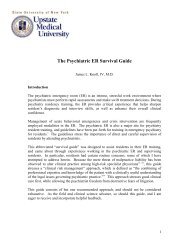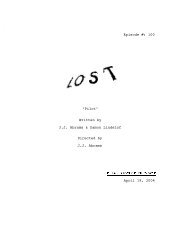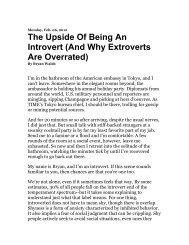Synchronicity Cambray
Synchronicity Cambray
Synchronicity Cambray
Create successful ePaper yourself
Turn your PDF publications into a flip-book with our unique Google optimized e-Paper software.
At play in this interface between modern physics and the psyche,<br />
as Jung has come to know it through his observations, is a longing for<br />
insight into creation. <strong>Synchronicity</strong> as an “act of creation in time” is<br />
another of his ways of aphoristically defining the term. The search for<br />
the origins of creation, of course, is one of the places of great tension<br />
in our society, as between religious and scientific perspectives.<br />
A variety of theories of the origins and nature of the universe were<br />
developed in the wake of Einstein’s papers on relativity. Because the<br />
general theory of relativity leads to either an expanding or contracting<br />
universe, which Einstein considered wrong, he introduced the<br />
“cosmological constant” (in effect a “fudge factor”) to preserve a static<br />
universe. Later he was to regret this, calling it the “biggest blunder” of<br />
his life. I will give a few details of the controversies in cosmology from<br />
1922 through the 1950s (for a detailed study see Big Bang by Simon<br />
Singh, 2004), which would include the time frame for Jung’s formulations<br />
of the synchronicity hypothesis.<br />
In 1922 a Russian mathematician, Alexander Friedmann, published<br />
an article in which he looked at a variety of values for the cosmological<br />
constant including zero. The results without the constant lead to<br />
a dynamic, evolving cosmos, which Friedmann explained as “having<br />
been kick-started with an initial expansion, so it would have an impetus<br />
with which to fight against the pull of gravity;” 40 his view was of<br />
origin from a single point. Einstein retaliated with a letter of complaint<br />
but was forced to retract this when Friedmann’s results proved<br />
to be sound mathematically. Because the journal was not well known,<br />
Einstein’s apology was not widely disseminated, and when Friedman<br />
died several years later his name had slipped below the horizon of scientific<br />
notables. However, affect was building around what vision of<br />
the universe would prevail; complexes were activated in the scientific<br />
community.<br />
The view of a dynamic, expanding universe was next put forward<br />
independently by Georges Lemaître, a Belgian who was both a physicist<br />
and a priest. Lemaître realized that the equations of general relativity<br />
lead to a moment of creation and proposed an extremely compact<br />
starting point he called the “primeval atom.” 41 In sketching out details<br />
as he understood them, Lemaître gave the first scientific description<br />
The History of a Radical Idea ( 7 )









